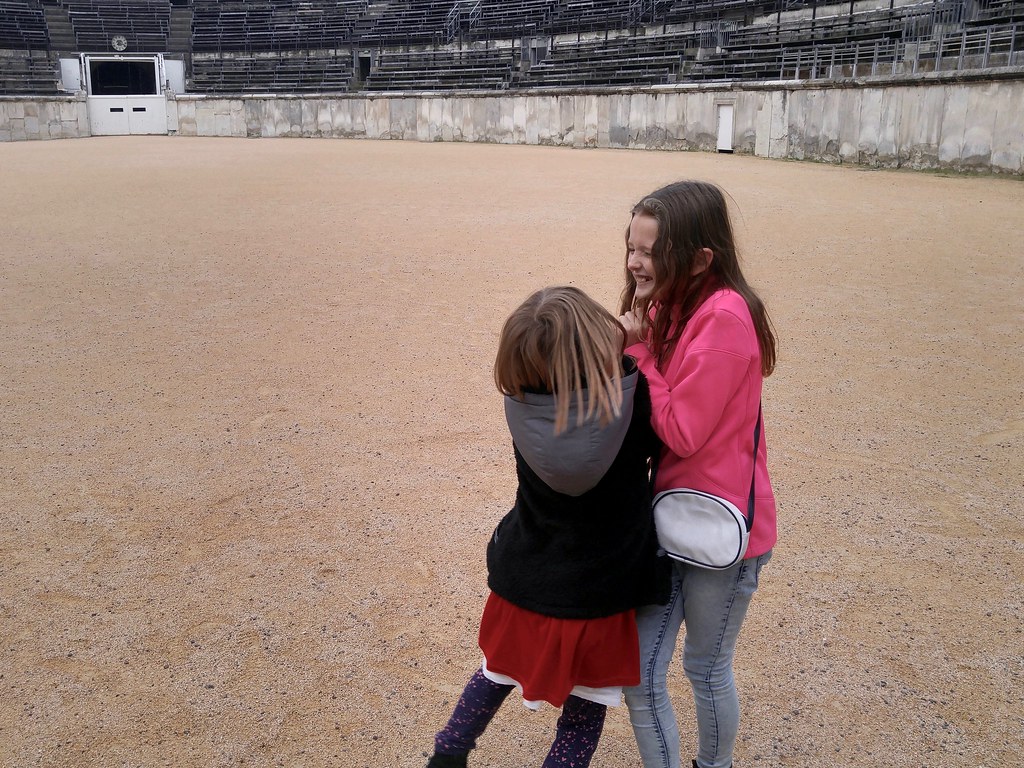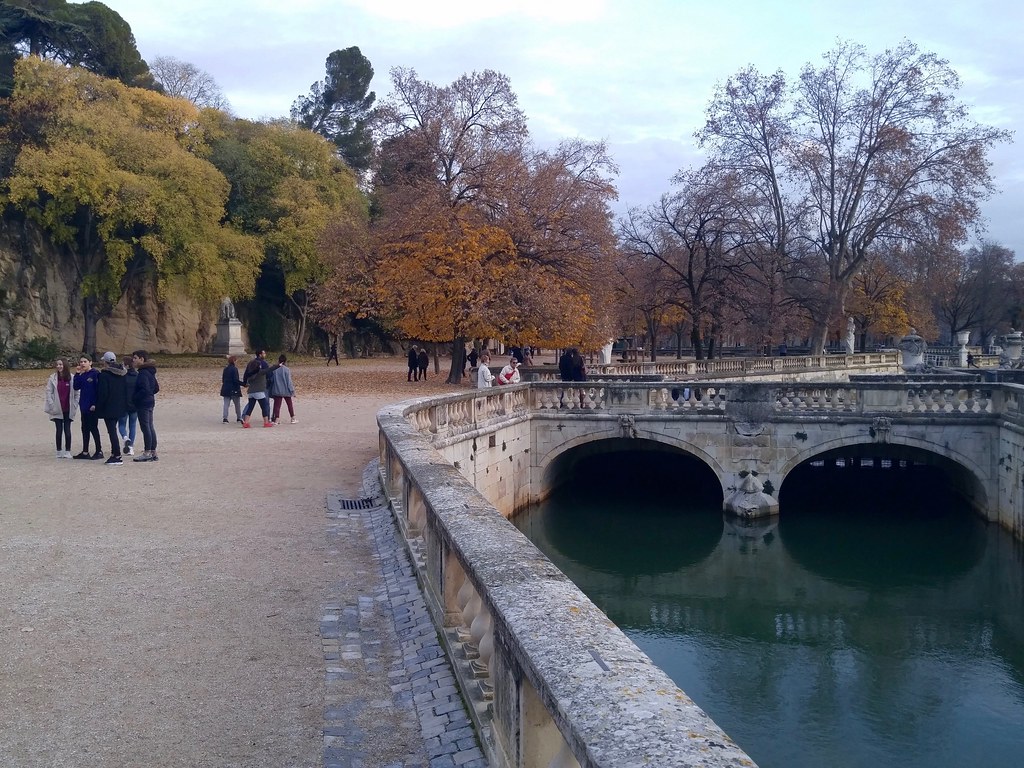At the end of October my family, plus Ruth's Mom and sister, spent a long
weekend in Barcelona. We went by train. The French and Spanish national
railways, SNCF and Renfe, jointly run a line between Paris and Barcelona. 4 to
7 (in summer) round trips are made between these major cities every day. Over
2 million passengers made the journey in 2015.
Montpellier is midway between Paris and Barcelona and there is a long stretch
of old track before and beyond Montpellier. 155 kilometers of new faster track
between Montpellier and Perpignan following the route of the A9 motorway has
been proposed to be built
before 2025. The existing route is much closer to the Mediterranean, and
traverses the many coastal lagoons. It's every bit as scenic and wonderful as
it is slow: chugging along narrow causeways between blue water and sky,
surrounded by oyster beds and flamingos and windsurfers.
I'm not the only one who finds this region so picturesque: there's a train
photography site with many shots taken around Port-la-Nouvelle.
Between Perpignan and Barcelona is new, high speed track and the 8 kilometer
Perthus tunnel through the Pyrenées. At 280 kph it's only
15 mins to Figueres, another 15 to Girona, then 30 to Barcelona. The train
ducks into a tunnel in the suburbs and parks underground at the Barcelona
Sants
station. There are no tracks above ground at the station and you can walk
away from it in any direction. After checking out the huge metal dragon and
slide at the Parc de l'Espanya Industrial, we walked toward Avinguda del
Paral·lel.
Barcelona is a big city. My kids were taken aback at first. They'd been to
Los Angeles in the spring, which is bigger, but not so urbanized. The solid
blocks of 7-8 floor buildings took a little getting used to.
I was immediately impressed by Barcelona's generous sidewalks and crosswalks.
It felt safe to walk in central Barcelona. More than safe, even, it felt
right to walk. Walking is a first-class activity. I can't think of another
city where I've had quite the same feeling.
After unpacking we wandered past all the pintxos bars on Calle Blai to Bar
Seco, on a more peaceful corner at the foot of Montjuïc. Ruth's sister has been
working and traveling in Latin America all her adult life and speaks Spanish
very well, so we had no obstacles to getting properly fed in Barcelona. My kids
are deeply skeptical about European food at the moment and ate almost nothing
on this trip other than papas bravas and green salads. Happily, Bar Seco did
both of these very well. It also had a good selection of local craft beers,
including a hoppy one, La Pirata Viakrucis.
The following day was a busy one. We walked from our apartment up to Avinguada
Miramar and rode the telefèric to Castell de Montjuïc, the infamous citadel on
the hill overlooking the port and city. Many communists and Catalan activists
suffered and died within its walls. On October 15, 1940, the President of
Catalunya, Lluís Companys, was shot dead by the Franco regime in the moat of
the castle. From Wikipedia: "Companys is the only incumbent democratically
elected president in European history to have been executed." It was sobering
to consider the Spanish Civil War and the Franco's dictatorship at the end of
October and even more so today.
Afterwards, we rode the funicular and metro to the Sagrada Família, Antoni Gaudí's
extraordinary basilica. My brief experience with the Barcelona metro was
a positive one. It's clean and runs properly and is easy to navigate. There's
a stop right at the church.
The Sagrada Família has an enormous amount of stained glass and the light
inside is over the top. The colors of the rainbow are everywhere.
We went up the towers and got some great views from above. I've read that
the 45 degree building cuts at block corners, which turn intersections into
large diamond shaped plazas, are required urban design elements in Barcelona.
That evening, we ate at Taps Bar, a cozy place decorated with mid-century
antiques. I had sardines, which I ordered at every opportunity, and snails
(caragol in Catalan) for the first time, in a delicious sauce of ham,
chorizo, tomato, garlic, paprika, thyme, and black pepper. People eat a few
different species of snails here in southwest Europe, the shells of the ones
I ate suggest that they were Cornu aspersum.
Saturday morning we took a bus to Barcelona's Gothic Quarter and the Picasso
Museum. The Barri Gotic has a medieval character not unlike Montpellier's
centre ville, its tiny cobbled squares connected by narrow alleys.
Afterwards we wandered around the Parc de la Ciutadella for a while and
rented a little barque to paddle around a pond. Multiple late nights caught up
with us a bit at this point. While, Ruth and her Mom took the kids back to the
apartment for naps, Ruth's sister and I did a quick tour of other sites
like the Catedral de la Santa Creu i Santa Eulàlia, la Rambla, and the Casa
Batlló.
We all met up for dinner in the Eixample district at a restaurant named
Vinitus. My favorite tapa dish here was baked salt cod with a sauce of tomatoes
and honey. By the time we left, people were lining up halfway down the block to
get in. Fortunately, they were getting cocktail service in line.
The almost uniform excellence of food and service in Barcelona is uncanny. It's
also uncanny how a restaurant like Vinitus can be simultaneously chic,
affordable, and family friendly. In France or the United States, you generally
have to pick two of these three qualities. A bonus: wines in a Catalan
restaurant, especially local wines, cost not much more than the price of
a dish. I'm still not over this!
Sunday I went on a long training run along the boardwalk next to the
Mediterranean, through the renovated port (which reminded me very much of San
Francisco's Embarcadero), and back up and over Montjuïc. If I'd done more
homework before the trip, I would have known that there was a huge 10k race in
El Raval that morning. I saw runners gathering near the port as I passed.
At noon we walked uphill to the Fundació Joan Miró and toured the museum. I found myself thinking
a lot about how Miró remained motivated and able to do creative work through
such troubled times in Spain and Catalunya. Recommendations, if you have any,
for biographies of mid-20th century Catalan artists, writers, and designers are
very welcome. As impressive as the museum, in my opinion, are the botanical
gardens around around them.
For our last night out in Barcelona, we went back to Calle Blai for pintxos and
drinks before La Fíbula, an Arabic restaurant, opened. Pintxo is Basque for
"thorn" and refers to the pointy wooden stick used to pin some savory
ingredient – sausage, fish, roasted vegetables, etc. – to a slice of baguette.
My kids picked out pintxos of chips and guacamole (no, really!). If I recall,
the reason why I don't have a picture is that my phone was dying. Sadly for
them, it turned out to be the infamous green pea guacamole. I was too hungry to
be picky, and gobbled them along with a pair of spicy sausage pintxos and
a large Estrella Damm. La Fíbula was good, of course, my only regret being that
I ate way too many honey and rose water-drenched deserts.
Ruth's Mom and sister headed back to Seattle on Monday and the rest of us went
back to Montpellier on a train full of French families.
Before this trip, my experience in Spain was one afternoon at the Dalí
Theatre-Museum in Figueres and another at State of the Map in Girona. I'm so
glad we made the time to visit Barcelona. Clearly, there's so much more to this
city than we could see in 4 days. I'd love to go back.
Apologies if I've mixed up Spanish and Catalan street and place names here. I'm
new to these languages and am not always sure which is which.

























